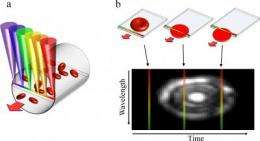New microscope uses rainbow of light to image the flow of individual blood cells

Blood tests convey vital medical information, but the sight of a needle often causes anxiety and results take time. A new device developed by a team of researchers in Israel, however, can reveal much the same information as a traditional blood test in real-time, simply by shining a light through the skin. This optical instrument, no bigger than a breadbox, is able to provide high-resolution images of blood coursing through our veins without the need for harsh and short-lived fluorescent dyes.
"We have invented a new optical microscope that can see individual blood cells as they flow inside our body," says Lior Golan, a graduate student in the biomedical engineering department at the Israel Institute of Technology, or Technion, and one of the authors on a paper describing the device that is published today in the Optical Society's (OSA) open-access journal Biomedical Optics Express. By eliminating a long wait-time for blood test results, the new microscope might help spotlight warning signs, like high white blood cell count, before a patient develops severe medical problems. The portability of the device could also enable doctors in rural areas without easy access to medical labs to screen large populations for common blood disorders, Golan notes.
Using the new microscope, the researchers imaged the blood flowing through a vessel in the lower lip of a volunteer. They successfully measured the average diameter of the red and white blood cells and also calculated the percent volume of the different cell types, a key measurement for many medical diagnoses.
The device relies on a technique called spectrally encoded confocal microscopy (SECM), which creates images by splitting a light beam into its constituent colors. The colors are spread out in a line from red to violet. To scan blood cells in motion, a probe is pressed against the skin of a patient and the rainbow-like line of light is directed across a blood vessel near the surface of the skin. As blood cells cross the line they scatter light, which is collected and analyzed. The color of the scattered light carries spatial information, and computer programs interpret the signal over time to create 2-D images of the blood cells.

Currently, other blood-scanning systems with cellular resolution do exist, but they are far less practical, relying on bulky equipment or potentially harmful fluorescent dyes that must be injected into the bloodstream.
"An important feature of the technique is its reliance on reflected light from the flowing cells to form their images, thus avoiding the use of fluorescent dyes that could be toxic," Golan says. "Since the blood cells are in constant motion, their appearance is distinctively different from the static tissue surrounding them." The team's technique also takes advantage of the one-way flow of cells to create a compact probe that can quickly image large numbers of cells while remaining stationary against the skin.
At first, the narrow field of view of the microscope made it difficult for the team to locate suitable capillary vessels to image. To solve this, the researchers added a green LED and camera to the system to provide a wider view in which the blood vessels appeared dark because hemoglobin absorbs green light. "Unfortunately, the green channel does not help in finding the depth of the blood vessel," notes Golan. "Adjusting the imaging depth of the probe for imaging a small capillary is still a challenge we will address in future research."
The researchers are also working on a second generation system with higher penetration depth.
The new system might expand the range of possible imaging sites beyond the inside lip, which was selected as a test site since it was rich in blood vessels, has no pigment to block light, and doesn't lose blood flow in trauma patients.
Additional steps include work to miniaturize the system for ease of transport and use. "Currently, the probe is a bench-top laboratory version about the size of a small shoebox," says Golan. "We hope to have a thumb-size prototype within the next year."
More information: "Noninvasive imaging of flowing blood cells using label-free spectrally encoded flow cytometry," Golan et al., Biomedical Optics Express, Vol. 3, Issue 6, pp. 1455-1464 (2012). www.opticsinfobase.org/boe/abs … cfm?uri=boe-3-6-1455
Provided by Optical Society of America


















